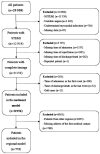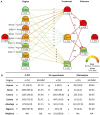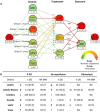Assessment of distance to primary percutaneous coronary intervention centres in ST-segment elevation myocardial infarction: Overcoming inequalities with process mining tools
- PMID: 36698425
- PMCID: PMC9869225
- DOI: 10.1177/20552076221144210
Assessment of distance to primary percutaneous coronary intervention centres in ST-segment elevation myocardial infarction: Overcoming inequalities with process mining tools
Abstract
Objectives: In ST-segment elevation myocardial infarction (STEMI), time delay between symptom onset and treatment is critical to improve outcome. The expected transport delay between patient location and percutaneous coronary intervention (PCI) centre is paramount for choosing the adequate reperfusion therapy. The "Centro" region of Portugal has heterogeneity in PCI assess due to geographical reasons. We aimed to explore time delays between regions using process mining tools.
Methods: Retrospective observational analysis of patients with STEMI from the Portuguese Registry of Acute Coronary Syndromes. We collected information on geographical area of symptom onset, reperfusion option, and in-hospital mortality. We built a national and a regional patient's flow models by using a process mining methodology based on parallel activity-based log inference algorithm.
Results: Totally, 8956 patients (75% male, 48% from 51 to 70 years) were included in the national model. Most patients (73%) had primary PCI, with the median time between admission and treatment <120 minutes in every region; "Centro" had the longest delay. In the regional model corresponding to the "Centro" region of Portugal divided by districts, only 61% had primary PCI, with "Guarda" (05:04) and "Castelo Branco" (06:50) showing longer delays between diagnosis and reperfusion than "Coimbra" (01:19). For both models, in-hospital mortality was higher for those without reperfusion therapy compared to PCI and fibrinolysis.
Conclusion: Process mining tools help to understand referencing networks visually, easily highlighting its inefficiencies and potential needs for improvement. A new PCI centre in the "Centro" region is critical to offer timely first-line treatment to their population.
Keywords: Big data analytics; ST-segment elevation myocardial infarction; clinical pathways; percutaneous coronary intervention; process mining tools.
© The Author(s) 2023.
Conflict of interest statement
The authors declared no potential conflicts of interest with respect to the research, authorship, and/or publication of this article.
Figures




References
-
- Townsend N, Wilson L, Bhatnagar Pet al. et al. Cardiovascular disease in Europe: epidemiological update 2016. Eur Heart J 2016; 37: 3232–3245. - PubMed
-
- Instituto Nacional de Estatística - Causas de Morte: 2017. Lisboa: INE. ISSN 2183-5489. ISBN 978-989-25-0481-0, https://www.ine.pt/xurl/pub/358633033 (2019).
-
- Every NR, Hochman J, Becker Ret al. et al. Critical pathways: a review. Committee on Acute Cardiac Care, Council on Clinical Cardiology, American Heart Association. Circulation 2000; 101: 461–465. - PubMed
-
- Fernandez-Llatas C, Valdivieso B, Traver Vet al. et al. Using process mining for automatic support of clinical pathways design. Methods Mol Biol 2015; 1246: 79–88. - PubMed
-
- Van der Aalst W. Process mining: data science in action. 2nd ed. New York: Springer Berlin Heidelberg, 2016.
LinkOut - more resources
Full Text Sources
Miscellaneous

